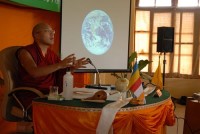法王新闻 | 2009年10月
召開第二屆噶舉傳承環保會議【第二天日誌】
Environmental Conference Day Two: Gyalwang Karmapa Explains Scientific View of Cosmology
地點:印度 上密院
時間:2009年10月04日 Sunday 4th October, 2009
報導:Tashi Paljor
攝影:Tashi Paljor

上午議程 The Morning Session
法王噶瑪巴發表「宇宙﹑生態﹑與佛教」演說Gyalwang Karmapa on the Universe, Ecology and Buddhism
由於許多的寺院代表沒有研習現代科學的機會,所以在上午議程的一開始,法王以投影片演說科學的宇宙觀,展示宇宙的浩瀚無垠,以及存在於其中的地球與太陽系的渺小。
Many of the monastic representatives have not had the chance to study modern science so Gyalwang Karmapa began by giving a slide-show presentation of scientific cosmology in which he demonstrated the vastness of the universe and the minuteness of earth and the solar system within it.
法王先是以地球為起點,解釋地球是太陽系中的第三個行星,就大小而言,木星比地球大114倍,而太陽又比木星大900倍。接著法王說明太陽系在銀河系中的位置,並且講解需要定義「光年」來測量星球之間的寬廣距離。最後法王描述整個宇宙的廣袌,並且展示了我們所居住的銀河系(縱橫有10萬光年的距離),在與廣大的宇宙相比之下,可以說是微不足道。法王也同時評論,佛經中也可以找到對宇宙的遼闊與黑洞的詳細描述。
Using earth as his starting point, he illustrated its position as the very small planet, third from the sun, comparing its size with Jupiter (1114 times bigger) and the sun (900 times bigger than Jupiter). From that he moved to the solar system’s place in the Milky Way galaxy, explaining the need to use light years to measure vast distances, and, then, finally, he described the universe, and demonstrated how even something as vast as our galaxy (100, 000 light years across) was minute when compared with the universe itself. By this stage everyone was staggering at the impossibility of even conceiving of such vastness. His Holiness commented that details about the vastness of the universe and even about so-called black holes, could be found in Buddhist scripture.
法王接著特別強調地球的特殊性。法王指出太陽光行抵地球的時間需要8分鐘,若是多一分鐘或是少一分鐘,地球都無法孕育出生命。在浩瀚如斯的宇宙中,科學家至今也還找不到能孕育出生命的另一個星球。
Gyalwang Karmapa continued by highlighting the specialness of the earth. Light from the sun takes eight minutes to reach us; if it took either a minute longer or a minute less, life on earth would not be possible. Within the vast universe, so far, scientists had been unable to find another planet which supports life.
法王解釋太陽與月亮的重力場,如何影響地球上的水形成潮汐,並且說明地球上所有的水中,只有3%是可飲用水,剩下的是不可飲用的鹹水;而這3%的水,真正能使用上的只有1%,剩下的可飲用水則被貯存在南北兩極的冰層中,以及第三極喜馬拉雅山區中———特別是在西藏的冰層中。而西藏是亞洲大部份地區的水源地。
He explained how the moon and sun’s gravitational fields influence water on earth – the tidal oceans- and how, of all the water on earth, only 3% is drinkable, the rest being saltwater, and of that 3%, only 1% is available: the rest is stored in ice at the poles including the ‘third pole’- the Himalaya region, and especially Tibet. Tibet is the source of most of the drinking water for much of Asia.
法王接著探討人類在地球歷史中的地位。法王以一個圖表來展示在地球超過40億年的歷史中,曾經出現有許多的生命形態,如恐龍等等。而人類出現在地球上,只是近20萬年的事,但是,人類對地球所形成的影響卻是非常劇烈。
Gyalwang Karmapa then discussed the position of homo sapiens. He used a diagram to illustrate how the earth was more than 4 billion years old and there had been many life-forms previously, such as the dinosaurs, but homo sapiens was a recent arrival approximately 200,000 years ago. Yet, during that time, homo sapiens had had a great impact on the planet.
人類性喜過度索求。若某人得到一臺電視,那麼其他的人也都會跟著想要有台電視。現代人認為自己需要電視﹑手機,而很快地每個人都會想要有部車子。人類的活動對生態系統形成壓力,並進而擾亂破壞生態系統,造成了溫室效應。人為因素對環境所造成的影響與規模,已擴大到具毀滅性的結果。在古時候的中國,漁夫訓練鸕鶿來捕魚,一次捕獲一隻魚。而在現代漁夫使用拖網大量撈取海洋魚獲,無可挽回地耗盡海魚的存量。
Humans have the tendency to want too much. If somebody gets a television, everybody else wants one. Nowadays people think they need a television and a mobile phone, and soon everyone will want a car. It was human behaviour which had created greenhouse gases, and which was putting excessive pressure on, disrupting and destroying ecosystems. Humans affect their environment and the scale of the demands made on the environment has increased dramatically to devastating effect. In China, in the olden days, fishermen trained cormorants to catch fish for them, one-at-a-time. Nowadays great trawlers harvest the oceans and fishing stocks are becoming irreversibly depleted.
中觀教導我們對事物的本質應當存疑。而現代科學也已獲得與佛教類似的結論,認為萬事萬物都互有關聯﹑相互依存,或被稱之為「蝴蝶效應」。因此,我們應該考量自身行為對環境所造成的影響,並且生活地少欲知足。
In Madhyamika philosophy we are taught to question the fundamental nature of things. Modern science has reached similar conclusions to Buddhism, that everything is interconnected and interdependent; what is sometimes called ‘the butterfly effect’. Thus it was very important that we consider the effect of our actions on the environment, and that learn to live with less.
地球就像是在浩瀚宇宙中的一粒塵沙,但也是我們唯一的家,除此之外,我們無處可去。交互地責難並非問題的解決之道,我們必須共同合作來保育地球。
This earth is like a grain of sand in the vastness of the cosmos, but it is our only home and we have nowhere else to go. There is no point apportioning blame. We have to work together to preserve and protect it.
尼泊爾佛教聯盟的演講
Presentation by Nepal Buddhist Federation
尊敬的圖藤.吉爵(Ven.Thubten Jigdrel)簡短地介紹了該聯盟的活動。尼泊爾佛教聯盟僧俗二眾為建立一個「無塑膠」的環境而聯手合作,現今已舉辦有一場環境與野生動物保育研討會。
The Ven.Thubten Jigdrel gave a short presentation on the work of this non-sectarian Buddhist organisation, which includes ordained and laypeople working together. The N.B.F. has worked to establish a plastic-free environment and has held a seminar on environmental education and the preservation of wildlife.
法王測試各寺院代表
Gyalwang Karmapa Tests the Representatives
法王最後半認真地測試在場的寺院代表,看看眾人還記得哪些上午所講解的科學知識。
His Holiness gave a tongue-in-cheek exam, to check up on what people remembered of the science from the morning session.
